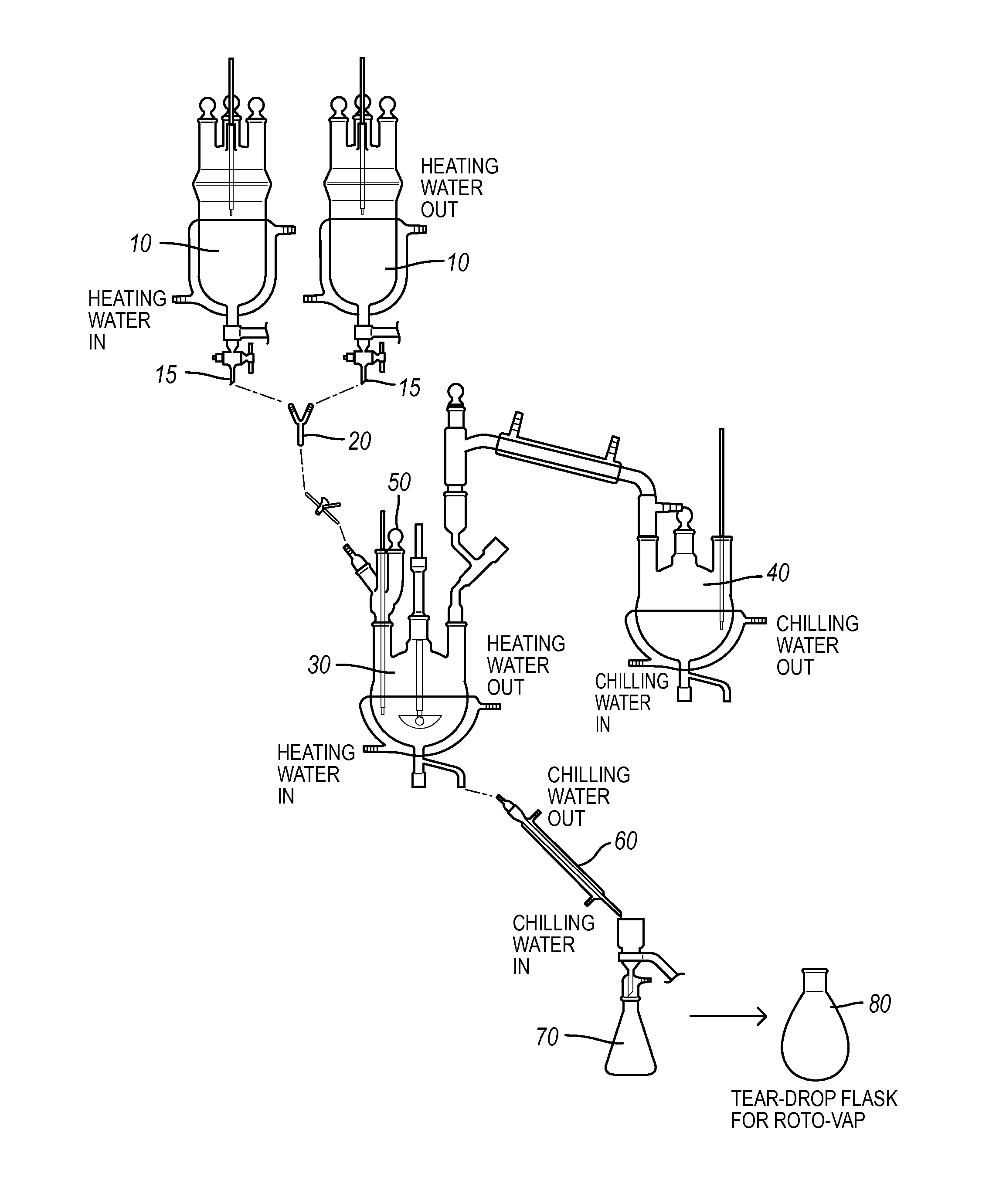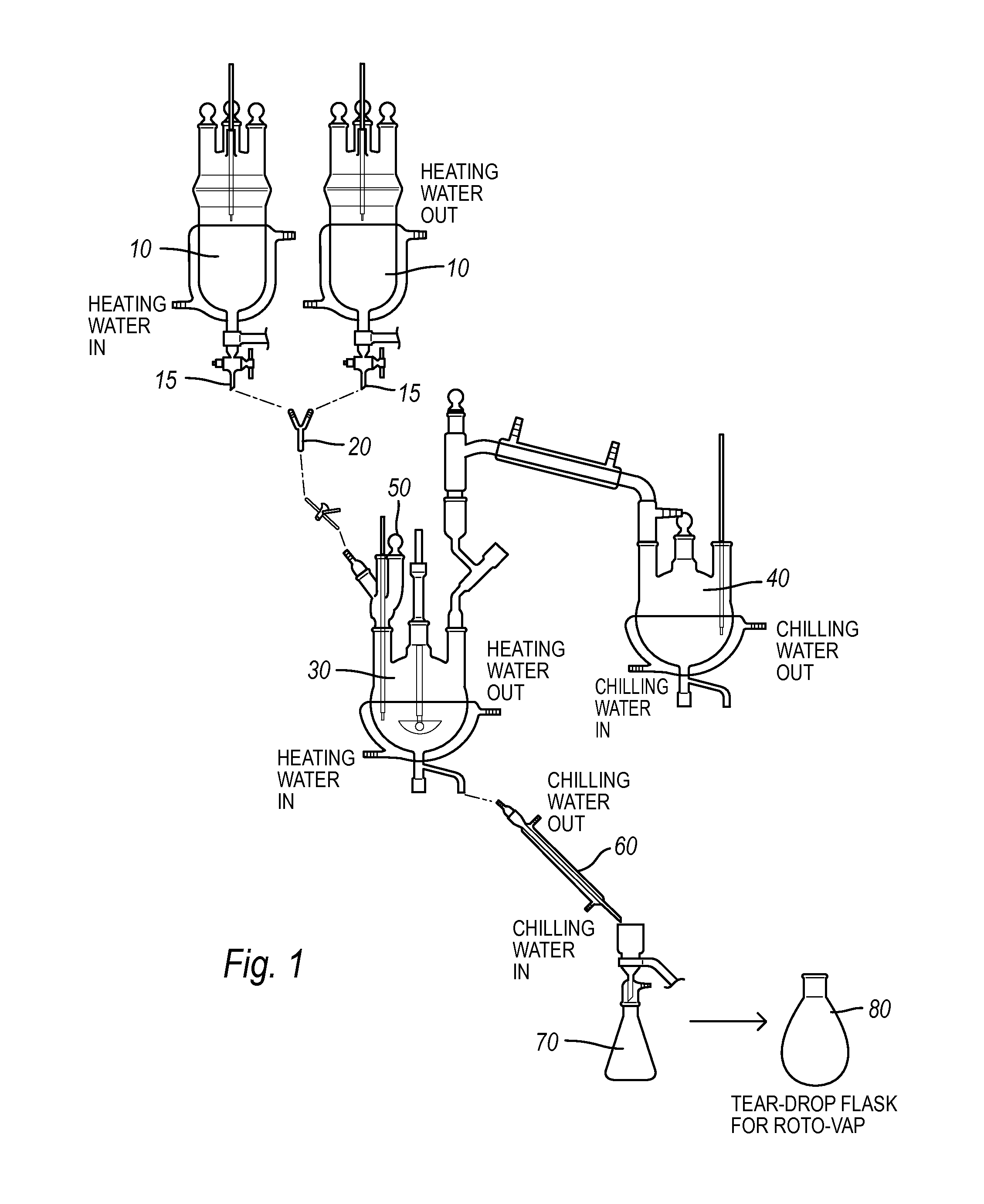Single step transesterification of biodiesel feedstock using a gaseous catalyst
a biodiesel feedstock and catalyst technology, applied in the preparation of carboxylic compounds, waste based fuels, fatty acid chemical modifications, etc., can solve the problems of increasing the production cost of biodiesel, adding cost and complexity to the biodiesel production process, and biodiesel production and use does not significantly contribute to global warming, etc., to facilitate the production of gaseous catalysts, facilitate the reaction, and facilitate the effect of reaction
- Summary
- Abstract
- Description
- Claims
- Application Information
AI Technical Summary
Benefits of technology
Problems solved by technology
Method used
Image
Examples
example 1
Method of Growing Algae and Processing Feedstock
[0118]Six shallow, parallel troughs oriented from north to south are prepared by hand using shovels. The total length of each of the troughs is approximately 100′. The total area used in the example is approximately 50′ by 100′. Into each trough is placed an unfilled 100′ bioreactor pipe extruded from polyethylene plastic.
[0119]Prepared media is added to the bioreactor pipes until the bioreactor pipes are substantially full. Urea is used as a nitrogen source, and a urease enzyme is added as well. The bioreactor pipes are inoculated by opening the valve located between a “nursery” bioreactor and the bioreactor pipes. The algal strain used for inoculation is Pseudochlorococcum sp.
[0120]The culture is allowed to grow until growth slows, as indicated by an increase in turbidity as well as a plateau in cell counts per mL of culture. About 5000 L of algal culture is then centrifuged at about 5 k rpm for about 10 minutes to pellet the algal b...
example 2
Method of Processing Algal Feedstock
[0128]Referring to FIG. 1, the biomass feedstock is added to two 5 L reaction chambers (10) (upper left). The chambers are jacketed to allow for the flow of heated water around the reaction chamber to maintain a constant reaction temperature.
[0129]After the reaction is complete, the chambers are drained from their lower ends, with the drain tubes (15) coming together in a Y-connector (20). The reaction product is drained to the distillation vessel (30) (middle-left of FIG. 1) where the temperature of the reaction product is raised to distill off the methanol / HCl catalyst. The catalyst is collected (middle-right of FIG. 1) in a chilled chamber (40) for re-use.
[0130]Following distillation, petroleum ether is added to the reaction product (middle-left of FIG. 1) via a 3-way adaptor (50). After mixing, the material can drain out from the bottom of the distillation vessel (30), through a condenser tube (60), through a Buchner filter, and into a collect...
example 3
Method of Processing Ground Meat Feedstock
[0132]About 50 g of dried ground beef is added to about 100 mL of methanol. The mixture is stirred for about an hour at about 60° C. About 300 mL of 3N Methanol / HCl is added to the mixture, and the stirring continues for about 3 additional hours.
[0133]The reaction is then filtered through glass fiber filters and the resulting filtrate is heated to about 65° C. for about 15 minutes to “flash” evaporate the methanol and HCl.
[0134]About 150 mL of petroleum ether is added to the flashed reaction and mixed. After about 4 hours, the supernatant is removed and flash evaporated at about 70° C.+ to remove non-biodiesel material. About 10 microliters aliquot of the biodiesel product is added to about 500 microliters heptane containing methyl ester standard (C:15) and FAME analysis is performed with gas chromatography equipment.
PUM
 Login to View More
Login to View More Abstract
Description
Claims
Application Information
 Login to View More
Login to View More - R&D
- Intellectual Property
- Life Sciences
- Materials
- Tech Scout
- Unparalleled Data Quality
- Higher Quality Content
- 60% Fewer Hallucinations
Browse by: Latest US Patents, China's latest patents, Technical Efficacy Thesaurus, Application Domain, Technology Topic, Popular Technical Reports.
© 2025 PatSnap. All rights reserved.Legal|Privacy policy|Modern Slavery Act Transparency Statement|Sitemap|About US| Contact US: help@patsnap.com



